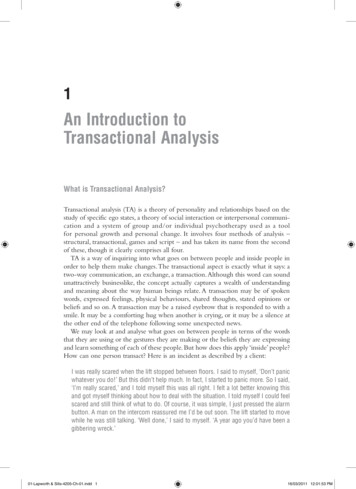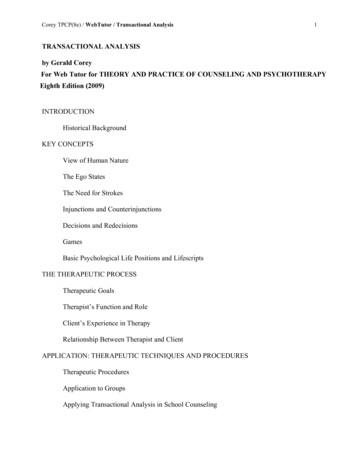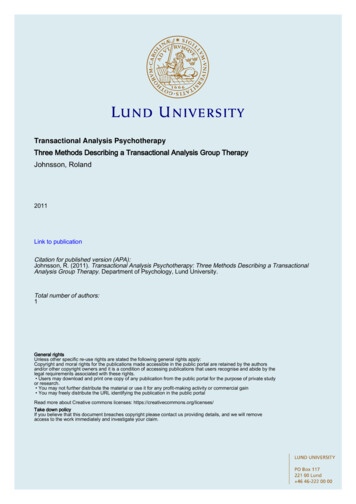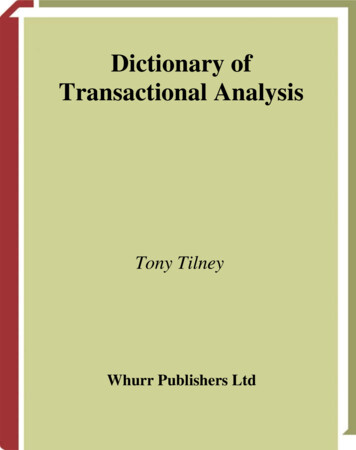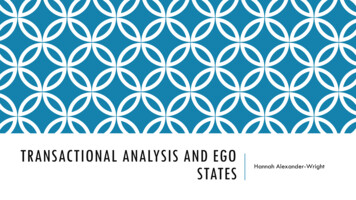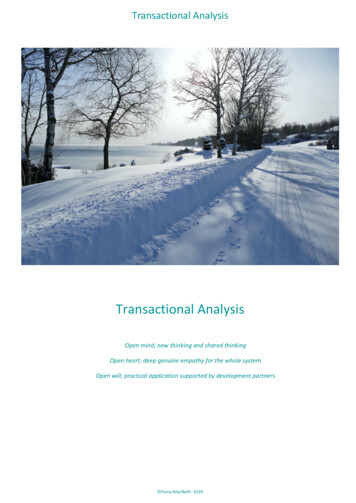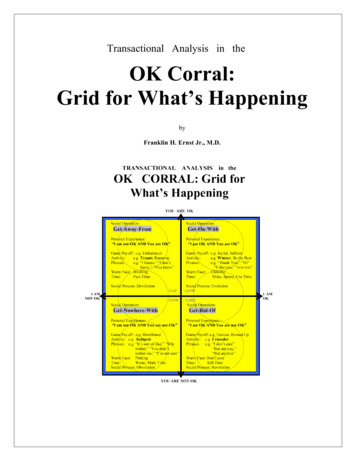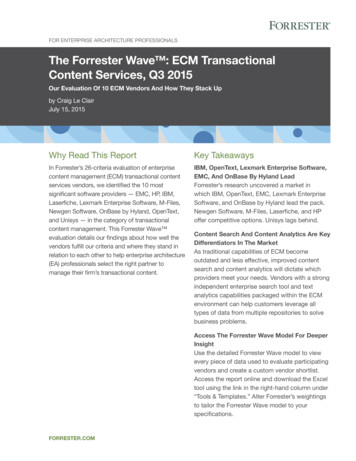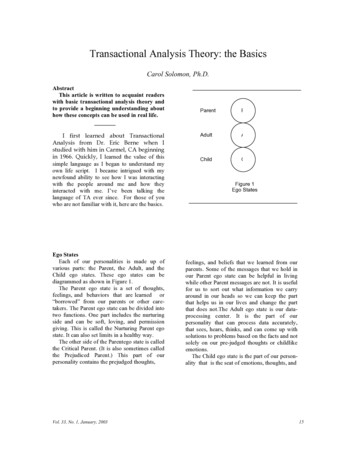
Transcription
Transactional Analysis Theory: the BasicsCarol Solomon, Ph.D.AbstractThis article is written to acquaint readerswith basic transactional analysis theory andto provide a beginning understanding abouthow these concepts can be used in real life.I first learned about TransactionalAnalysis from Dr. Eric Berne when Istudied with him in Carmel, CA beginningin 1966. Quickly, I learned the value of thissimple language as I began to understand myown life script. I became intrigued with mynewfound ability to see how I was interactingwith the people around me and how theyinteracted with me. I’ve been talking thelanguage of TA ever since. For those of youwho are not familiar with it, here are the basics.Ego StatesEach of our personalities is made up ofvarious parts: the Parent, the Adult, and theChild ego states. These ego states can bediagrammed as shown in Figure 1.The Parent ego state is a set of thoughts,feelings, and behaviors that are learned or“borrowed” from our parents or other caretakers. The Parent ego state can be divided intotwo functions. One part includes the nurturingside and can be soft, loving, and permissiongiving. This is called the Nurturing Parent egostate. It can also set limits in a healthy way.The other side of the Parentego state is calledthe Critical Parent. (It is also sometimes calledthe Prejudiced Parent.) This part of ourpersonality contains the prejudged thoughts,Vol. 33, No. 1, January, 2003ParentPAdultAChildCFigure 1Ego Statesfeelings, and beliefs that we learned from ourparents. Some of the messages that we hold inour Parent ego state can be helpful in livingwhile other Parent messages are not. It is usefulfor us to sort out what information we carryaround in our heads so we can keep the partthat helps us in our lives and change the partthat does not.The Adult ego state is our dataprocessing center. It is the part of ourpersonality that can process data accurately,that sees, hears, thinks, and can come up withsolutions to problems based on the facts and notsolely on our pre-judged thoughts or childlikeemotions.The Child ego state is the part of our personality that is the seat of emotions, thoughts, and15
CAROL SOLOMONfeelings and all of the feeling state “memories”that we have of ourselves from childhood. Wecarry around in our Child ego states all of theexperiences we have had, and sometimes thesechildlike ways of being pop up in our grown-uplives. This can be fun when we are in a situation in which it is safe and right to play and enjoy ourselves. It can be a problem when ourChild view of the world causes us to distort thefacts in a current situation and prevents ourAdult ego state from seeing things accurately.The Child ego state can also be divided intotwo parts: the Free Child ego state (also referred to as the Natural Child) and the AdaptedChild ego state (which also contains the Rebellious Child ego state).The Free Child is the seat of spontaneousfeeling and behavior. It is the side of us that experiences the world in a direct and immediateway. Our Free Child ego state can be playful,authentic, expressive, and emotional. It, alongwith the Adult, is the seat of creativity. Havinggood contact with our own Free Child is an essential ingredient for having an intimate relationship. When we adapt in ways that make usless in touch with our true selves (our FreeChild), we decrease the amount of intimacy weare able to have in our lives.The Adapted Child is the part of our personality that has learned to comply with the parental messages we received growing up. We alladapt in one way or another. Sometimes whenwe are faced with parental messages that arerestricting, instead of complying with them, werebel against them. This becomes our Rebellious Child ego state. This can be seen as analternative to complying. It is still, however, aresponse to the parent messages, and so it is akind of adaptation all its own.Let's take a very simple example of a childplaying in the sand and look at how the different content develops in the different egostates:Nurturing Parent: Go ahead, play and havefun!Critical Parent: Now, don't you DARE getyourself all messy!Adult: This sand looks really interesting. Ican make a castle.Free Child: WOW! Look how tall my castleis!!!!!16Adapted Child: I better not get my clothesall dirty.Rebellious Child: I don't CARE if I do getdirty! (While dumping a bucket of sand onher head)Understanding ego states is the basis for understanding transactional analysis theory. In thefollowing section we will look at different waysof identifying what ego state you or someoneelse is using so you can become adept at recognizing these aspects of personality and behavior. As you watch people move from oneego state to another, you can literally see themchange right before your eyes!How to Tell What Ego State You Are UsingThere are several ways to tell what ego stateyou are (or some one else is) using. Pay attention to tone of voice, body posture, gestures,choice of words, and emotional state. If thetone of voice is soft and soothing, this is a signthat the speaker is using a Nurturing Parent egostate. If, on the other hand, the tone is harshand critical or threatening, then the speaker isprobably using a Critical Parent ego state. Aneven and clear tone of voice usually comesfrom an Adult ego state, while an especiallycheerful or emotion-laden tone of voice islikely to be coming from the Free Child. TheAdapted Child may sound either whiney or likea good girl (or boy) saying just what is expected of her or him.Similarly, there are gestures that signify thatsomeone is using Parent (the warning, waggingfinger), Adult (thoughtful expression, noddinghead), or Child (jumping up and down). Thereare also specific words that tend to come fromone ego state more than from the others. TheParent is most likely to use expressions such as“Pay attention now” or “You should always doit this way,” while language belonging to theAdult ego state is likely to sound evenhanded(“This information might be useful to you”) orsimply factual (“Will you tell me what time itis?”). The Child is most likely to use shortexpressive words like “WOW!” “Yeah!” or“Let's go!” When you pay attention to thesebehaviors and to how you feel, you will be ableto tell what ego state you or someone else isusing.Transactional Analysis Journal
TRANSACTIONAL ANALYSIS THEORY: THE BASICSLet's look at ways in which an understandingof ego states can help you in your current life.Suppose we take a common problem and applyknowledge of ego states to the solution. Thefeeling of loneliness is a natural experience.Everyone feels lonely from time to time. Peopleask, “How can I connect with others? How canI make more friends?”You can use your knowledge of ego states ina social situation to maximize your chances ofmaking new connections. Let your NurturingParent take your Child to a party. Reassureyourself by saying things like, “This might befun. Let's see what interesting people we mightbe able to meet!” Leave your Critical Parent athome. Smile at people. When others talk toyou, use your Nurturing Parent to make supportive comments and to offer strokes. Use yourAdult to ask questions, showing the other person that you are interested in him or her. Allowyour Natural Child to be intuitive and to figurepeople out. Your Child ego state can connectwith others not only sharing in the pleasure ofjokes that are funny, but sometimes findinghumor in ordinary situations as well. You mightfind others opening up to you. We all needwarmth and positive strokes; if you offer someof them to others, it is likely that some willcome back your way. These elements of nurturance, support, a show of interest, andplayfulness are often how friendships begin.Change does not necessarily come quickly oreasily. Change takes practice. Your transactional analysis therapist can help you with this.But once you start making changes that moveyour life in a positive direction, you can expectmore positive changes to follow.TransactionsAnother important transactional analysisconcept is that of transactions. Transactions areabout how people interact with each other,specifically, which ego state in me is talking towhich ego state in you. You may have noticedthat sometimes communication continues in astraightforward, easy way that seems to gosmoothly. But at other times, things seem to getall jumbled up, confusing, unclear, and unsatisfying. An understanding of transactionscan help you keep your communication withothers as clear as you would like it to be.Straight transactions (or complementarytransactions): We can diagram simple, straighttransactions as shown in Figure 2.PPPPAAAACCCCAdult: “Will you tell me what time it is?”Adult: “Yes, it is four o’clock.”Parent: “You have to go to bed right now!”Child: “Please Can’t I just finish thisshow?”Figure 2Straight TransactionsVol. 33, No. 1, January, 200317
CAROL SOLOMONThe first example is easy to understand. Inthe second example the two people are not inagreement, however the communication isclear. Both are examples of straight transactions; the arrows are straight or parallel. Whenpeople use straight (or complementary)transactions, communication can continueindefinitely. It is when people cross transactionsthat communication breaks down.Crossed transactions: We can diagram acrossed transaction as shown in Figure 3.Here we see two different examples in whichcommunication breaks down. In the first, therespondent comes from a Child ego state instead of Adult, thereby crossing the transaction.The speaker has two options. She can eitherstay in her Adult ego state and try again to hookthe Adult in the responder (“I didn't mean torush you. I really just wanted to know thetime”), or she can get hooked and move intoher Parent ego state and respond that way (e.g.,saying angrily, “Why do you have to be sosensitive?”). In the second example, the respondent comes from a Critical Parent ego state tocross the transaction, and this communicationbreaks down. There are many other ways tocross transactions.When we learn to recognize and differentiatebetween straight and crossed transactions weincrease our ability to communicate clearlywith others. Conversations made up of straighttransactions are more emotionally satisfyingand productive than conversations that havefrequent crossed transactions.Becoming an expert at recognizing ego statesand straight and crossed transactions takes time.In the beginning you will need to pay closeattention to what is going on both insideyourself and with others. With practice, identifying various ego states and different kinds oftransactions becomes second nature. Learningthese new skills can be interesting and helpful.It can also be fun!StrokesEric Berne defined a stroke as a “unit ofhuman recognition”. A stroke can be a look, anod, a smile, a spoken word, a touch. Any timeone human being does something to recognizeanother human being, that is a stroke. Babiesneed strokes to survive.Strokes can be positive or negative. Most ofus like positive strokes better than negativeones. It feels better to hear “I love you” than toPPPPAAAACCCCAdult: “Can you tell me what time it is?”Adapted Child: “Why are you alwaysrushing me?”Adult: “Can you tell me what time it is?”Critical Parent: “You’re always late, anyway,why would you even care?”Figure 3Crossed Transactions18Transactional Analysis Journal
TRANSACTIONAL ANALYSIS THEORY: THE BASICShear “I hate you.” But when children are notable to get positive strokes, they will make theirbest effort to get the negative ones, sincenegative strokes are better than no strokes atall. This is the reason that some people grow upbeing more comfortable with negative strokingpatterns. The kind of stroking patterns we develop tend to support our basic, existential lifeposition, a stance in life that reflects how wefeel about ourselves in relation to others.Strokes can also be unconditional or conditional. Unconditional strokes are those thatcome to us just for being. They are a very richkind of strokes. Babies who get lots of positive,unconditional strokes really thrive. And adultswho have a good base of positive unconditionalstroking thrive as well.Conditional strokes are given for what wedo, for what we accomplish, or for a particulartrait that we happen to possess. Thus, they arebased on some condition. Conditional strokescan fill important needs. If I sing well, or get agood grade, or do a good deed, and someonerecognizes me for that, they are giving me apositive conditional stroke. If people tell methat I am pretty or that they like my dress, theyare giving me a positive conditional stroke.These strokes can feel very good and they fillus up in different ways than do positiveunconditional strokes.But there are ways that conditional strokescan be limiting, too. If we relate to others orthey relate to us in ways that show us that weare only OK in their eyes when we behave incertain ways, this cuts down on the spontaneityin the relationship. In the long run, this canlimit pleasure, intimacy, and creativity.Pay attention to the kind of strokes you mostlike to get and learn ways to ask for them. Yes,it is OK to ask for strokes, and asking does notdiminish the value of the stroke you get!Usually the more you give, the more you get!The most harmful kind of stroke is the unconditional negative stroke. These strokes convey to us that we are not OK. And there is nocondition that this is based on. The unconditional negative stroke says that the core ofwho we are is just not OK. This kind of message and stroking pattern early in life canseriously impact a person's view of himself orVol. 33, No. 1, January, 2003herself; it can be damaging to the person's selfesteem and even impact his or her will or desireto live.When negative strokes are conditional, theyare a bit less harmful than the unconditionalnegative ones. At least the person can believethat there is something good about himself orherself, since the negative strokes
Transactional Analysis Theory: the Basics Carol Solomon, Ph.D. Abstract This article is written to acquaint readers with basic transactional analysis theory and to provide a beginning understanding about how these concepts can be used in real life. I first learned about Transactional Analysis from Dr. Eric Berne when I studied with him in Carmel, CA beginning in 1966. Quickly, I learned the .

